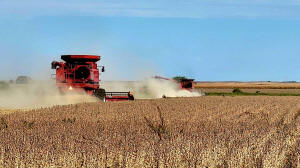|
The
program has Midwest farmers branching out to countries like
Egypt, Nigeria, and Honduras with a good measure of success. In
Illinois, where 60% of soybeans are exported, farmers are
looking to the program for stability in a changing global
climate.
Mark Read, an Illinois farmer and vice chair of the Soy
Excellence Center Steering Committee, told The Center Square
this training effort helps farmers in other lands maximize
soybean use.
Read notes that 40% of the nation’s soybean exports go to China
where politics have created an uncertain future.
“It’s very important that we diversify our products,” he said.
There’s also a humanitarian side to these efforts, according to
Read, “Some of these other countries are growing and they need
more protein in their diet.”
He noted that in places like Nigeria, only one in five babies
lives to the age of 5 partly due to protein deficiencies that
soybeans can help correct.
Meanwhile, the outlook is considered bright for U.S.-grown
soybeans with new markets being created for Midwest exports and
expanded use in fuel.
Not only are these new markets building confidence in the future
of soybeans as opposed to relying on China, but Illinois is
welcoming new crushing facilities for soybean fuel, according to
Read.
“Part of that is because of the demand for oil,” he said.
Both efforts put the approximately 43,000 Illinois soybean
farmers in what he called a “good position.”
To add to the Soy Excellence Centers launched in 2019 with
government funds, Read said there is a focus on new horizons,
some in need of a healthier diet.
“India could be a big future customer as they’ve got a lot of
people that need protein in their diet,” he said.

|
|




